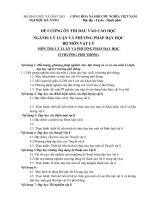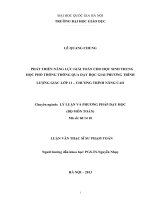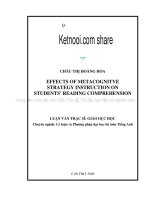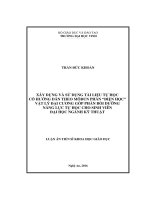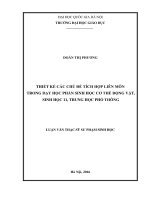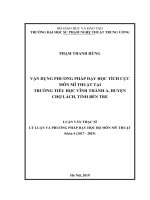LÝ LUẬN VÀ PHƯƠNG PHÁP DẠY HỌC BỘ MÔN TIẾNG ANH - LÝ THỊ ÁNH NGUYỆT - ENGLISH AS A FOREIGN LANGUAGE ADULT LEARNERS’ LEARNING STRATEGY PROBLEMS A CASE STUDY AT VINH LONG COMMUNITY COLLEGE
Bạn đang xem bản rút gọn của tài liệu. Xem và tải ngay bản đầy đủ của tài liệu tại đây (411.65 KB, 114 trang )
Ộ
Kho tai lieu Ketnooi.com
ENGLISH AS A FOREIGN LANGUAGE
ADULT LEARNERS’ LEARNING STRATEGY
PROBLEMS
A CASE STUDY AT VINH LONG
COMMUNITY COLLEGE
LUẬN VĂN THẠC SĨ: GIÁO DỤC HỌC
Chuyên ngành: Lí luận và Phương pháp dạy học bộ môn Tiếng Anh
CẦN THƠ, 2009
MINISTRY OF EDUCATION AND TRAINING
CAN THO UNIVERSITY
LÝ THỊ ÁNH NGUYỆT
ENGLISH AS A FOREIGN LANGUAGE
ADULT LEARNERS’ LEARNING STRATEGY
PROBLEMS
Trung tâm Học liệu ĐH Cần Thơ @ Tài liệu học tập và nghiên cứu
A CASE STUDY AT VINH LONG
COMMUNITY COLLEGE
Program: Principles and Methods in English Language Education
Program code: 60 14 10
MASTER THESIS: EDUCATION
Supervisor: TRƯƠNG THỊ KIM LIÊN
CANTHO, 2009
BỘ GIÁO DỤC VÀ ĐÀO TẠO
TRƯỜNG ĐẠI HỌC CẦN THƠ
LÝ THỊ ÁNH NGUYỆT
NHỮNG KHÓ KHĂN TRONG
CHIẾN LƯỢC HỌC TIẾNG ANH CỦA
HỌC VIÊN TRƯỞNG THÀNH
Trung tâm Học liệu ĐH Cần Thơ @ Tài liệu học tập và nghiên cứu
TẠI TRƯƠNG CAO ĐẲNG CỘNG ĐỒNG
VĨNH LONG
Chuyên ngành: Lí luận và Phương pháp dạy học Tiếng Anh
Mã số: 60 14 10
LUẬN VĂN THẠC SĨ: GIÁO DỤC HỌC
Người hướng dẫn khoa học: Th.s GVC: TRƯƠNG THỊ KIM LIÊN
CẦN THƠ, 2009
BỘ GIÁO DỤC VÀ ĐÀO TẠO
TRƯỜNG ĐẠI HỌC CẦN THƠ
LÝ THỊ ÁNH NGUYỆT
ENGLISH AS A FOREIGN LANGUAGE
ADULT LEARNERS’ LEARNING STRATEGY
PROBLEMS
Trung tâm Học liệu ĐH Cần Thơ @ Tài liệu học tập và nghiên cứu
A CASE STUDY AT VINH LONG
COMMUNITY COLLEGE
LUẬN VĂN THẠC SĨ: GIÁO DỤC HỌC
Chuyên ngành: Lí luận và Phương pháp dạy học bộ môn Tiếng Anh
CẦN THƠ, 2009
Luận văn đính kèm theo đây với tựa đề tài:
“ENGLISH AS A FOREIGN LANGUAGE ADULT LEARNERS’ LEARNING
STRATEGY PROBLEMS - A CASE STUDY AT VINH LONG COMMUNITY
COLLEGE”
do học viên Lý Thị Ánh Nguyệt thực hiện và báo cáo đã được Hội Đồng Chấm Luận
văn thông qua.
Ủy viên
(Ký tên)
Ủy viên
(Ký tên)
Trung tâm Học liệu ĐH Cần Thơ @ Tài liệu học tập và nghiên cứu
Phản biện 1
(Ký tên)
Phản biện 2
(Ký tên)
Cần Thơ, ngày ……..tháng………năm 2009
Chủ tịch hội đồng
(Ký tên)
i
CERTIFICATE OF ORIGINALITY
I hereby certify that this thesis entitled “English as a foreign language adult learners’
learning strategy problems - a case study at Vinh Long Community College” is my
own work.
I declare that this thesis has not been submitted for the award of any degree or diploma
at any other situations
Can Tho, 2009
Supervisor
Trương Thị Kim Liên
Lý Thị Ánh Nguyệt
Trung tâm Học liệu ĐH Cần Thơ @ Tài liệu học tập và nghiên cứu
ii
ACKNOWLEDGEMENTS
I count myself very fortunate to have had Ms. Truong Thi Kim Lien as my supervisor,
and I would like to show my great thanks for her patience, advice, and support during
the writing of the thesis.
I would like to express my special thanks to the instructors of MA class course 13,
who provided me with valuable knowledge so that I could finish my thesis.
I would also thank my colleagues who have helped gather data, who have assisted with
data analysis, and who have helped by reading and giving advice.
I am grateful to many students at Vinh long Community College who participated in
the study by filling out questionnaire and by attending the interviews.
Special thanks are due to the Head of Vinh Long Community College and the
colleagues in Socio- Economics Department for much support and encouragement
when I was studying and writing so that I could finish the thesis.
this paper
be possible
without
my family
Trung Finally,
tâm Học
liệucould
ĐH not
Cần
Thơ @
Tài liệu
họcwho
tậphave
và supported
nghiênme
cứu
much with love and encouragement.
iii
ABSTRACT
It is practically recognized that English learning in early and late adulthood has been an
urgent duty for learners in the time of information exchange and international integration in
Vietnam. However, it is proved not to be an easy task to fulfill, and learners face difficulties in
their English learning. This paper examined the extent to which EFL adult learners perceive
about language learning strategy problems. In addition, this paper considered the correlation
between those problems and the factor of age and other factors. In order to achieve these
objectives, a survey was conducted on 135 adult learners majoring in Bureau Administration
and Trade Union at Vinh Long Community College. The participants completed the basic
English course in three semesters each of which lasted for 60 to 90 periods. From the survey
result, 20 learners were selected for interview, and four classroom observations were carried
out.
The main findings of the survey showed that affective strategies were the most serious
problem. The results indicated that among the correlations between those language learning
strategy problems and age, gender, and belief about foreign language aptitude, the
correlation between the problems and age was considerably significant.
Trung tâm Học liệu ĐH Cần Thơ @ Tài liệu học tập và nghiên cứu
In short, the thesis investigated the extent to which EFL adult learners at Vinh Long
Community College perceived about language learning strategy problems. The paper
examined the correlations between age, gender and belief about foreign language aptitude
with those problems. Based on the findings, the study offered some recommendations to
teachers, learners, curriculum designers, and administrators in order to improve adult
learners’ English language learning strategies at Vinh Long Community College.
KEY WORDS: adult learners and learning, language learning strategy problems, memory
strategy problems, compensation strategy problems, affective strategy problems, social
strategy problems, belief about foreign language aptitude
iv
TÓM TẮT
Thực tiễn cho thấy việc học tiếng Anh của học viên trưởng thành là nhiệm vụ cấp thiết trong
thời đại trao đổi thông tin và hội nhập quốc tế. Tuy nhiên, những học viên thường gặp nhiều
khó khăn trong việc học tiếng Anh. Đề tài này khảo sát mức độ khó khăn trong chiến lựợc học
ngoại ngữ của những học viên trưởng thành. Ngoài ra, đề tài còn khảo sát xem có mối tương
quan nào giữa những khó khăn trên với yếu tố về độ tuổi và những yếu tố khác. Để đạt được
mục tiêu trên, một cuộc khảo sát được tiến hành trên 135 học viên trưởng thành đang theo
học các chuyên ngành Quản trị Văn phòng và Quản trị Công đoàn tại trường Cao đẳng Cộng
đồng Vĩnh long. Các học viên tham gia trong đề tài này đều đã hoàn tất chương trình Anh văn
cơ bản trong 3 học kì, mỗi học kì kéo dài từ 60 đến 90 tiết học. Qua kết quả khảo sát có 20
học viên được chọn để phỏng vấn. Ngoài ra còn có bốn cuộc quan sát được thực hiện trên lớp
học.
Kết quả cho thấy các học viên trưởng thành gặp khó khăn nhiều nhất trong chiến lược tình
cảm. Ngoài ra, trong các mối tương quan giữa những khó khăn trên với các yếu tố về độ tuổi,
giới tính và niềm tin về năng khiếu học ngoại ngữ, thì mối tương quan với độ tuổi là mạnh
nhất.
những
kết quả
tìm ĐH
được, Cần
đề tài đưa
ra những
đề xuất
với giảng
chuyên viên
Trung Từ
tâm
Học
liệu
Thơ
@ Tài
liệu
họcviên,
tậphọcvàviên,
nghiên
cứu
thiết kế chương trình giảng dạy, và các cấp có thẩm quyền với mong muốn giúp cho chiến
lược học tiếng Anh của các học viên trưởng thành tại trường Cao Đẳng Cộng Đồng Vĩnh
Long được tốt hơn và có hiệu quả hơn.
v
LIST OF ABBREVIATIONS
BAFLA
: Belief About Foreign Language Aptitude
CPH
: Critical Period Hypothesis
EFL
: English as a Foreign Language
L2
: Foreign / second language
LLSP
: Language Learning Strategy Problems
SILL
: Strategy Inventory for Language Learning
Trung tâm Học liệu ĐH Cần Thơ @ Tài liệu học tập và nghiên cứu
vi
TABLE OF CONTENTS
Certificate of originality ............................................................................................. ii
Acknowledgements .................................................................................................... iii
Abstract ..................................................................................................................... iv
Tóm tắt .......................................................................................................................v
List of abbreviations................................................................................................... vi
Table of contents ....................................................................................................... vii
List of figures ............................................................................................................. xi
List of tables ............................................................................................................. xii
CHAPTER 1: INTRODUCTION ............................................................................1
1.1 The rationale of the study ...............................................................................1
1.2 Aims and significance of the study .................................................................3
1.3 General background of the study ....................................................................3
Trung tâm1.4Học
liệu ĐH
Cần
@ Tài liệu học tập và nghiên cứu
Organization
of the
studyThơ
...............................................................................
5
CHAPTER 2: THEORETICAL FRAMEWORK ..................................................6
2.1 An overview of adult learners and learning ....................................................6
2.1.1 Adults ....................................................................................................6
2.1.2 Adult learners ........................................................................................7
2.1.3 Characteristics of adult learners .............................................................7
2.1.4 Adult learning ........................................................................................8
2.1.4.1 Principles of adult learning .........................................................8
2.1.4.2 Adult motivation to return to school ..........................................10
2.1.4.3 Barriers ....................................................................................11
2.2 Foreign language learning strategies.............................................................11
2.2.1 Definition of a language learning strategy ............................................11
2.2.2 Classification of language learning strategies .......................................12
2.2.3 Direct strategies ...................................................................................13
vii
2.2.4 Indirect strategies .................................................................................14
2.2.5 The importance of language learning strategies
in language learning..............................................................................15
2.3 Factors affecting language learning strategies ..............................................17
2.3.1 Age factor ............................................................................................18
2.3.2 Gender factor .......................................................................................20
2.3.3 Factor of belief about foreign language aptitude...................................22
2.3.3.1 Aptitude and foreign language aptitude .....................................22
2.3.3.2 Belief about foreign language aptitude ......................................22
2.4 Summary ......................................................................................................23
CHAPTER 3: RESEARCH METHOD ................................................................25
3.1 Research questions and hypotheses ..............................................................25
3.2 Research design ...........................................................................................25
3.2.1 Participants of the study .......................................................................26
Trung tâm Học liệu ĐH Cần Thơ @ Tài liệu học tập và nghiên cứu
3.2.1.1 Participant selection ..................................................................26
3.2.1.2 Characteristics of the participants ..............................................27
3.2.2 Instruments ..........................................................................................31
3.2.2.1 Questionnaire ............................................................................32
3.2.2.2 Interview ...................................................................................35
3.2.2.3 Observation...............................................................................37
3.3 Summary ......................................................................................................40
CHAPTER 4: RESULTS .......................................................................................41
4.1 Learners’ responses to the survey questionnaire ...........................................41
4.1.1 Learners responses to the difficulties in
language learning strategies ................................................................41
4.1.1.1 Learners’ responses to memory strategy problems ...................43
4.1.1.2 Learners’ responses to compensation strategy problems ...........44
viii
4.1.1.3 Learners’ responses to affective strategy problems ...................45
4.1.1.4. Learners’ responses to social strategy problems .......................46
.
4.1.1.5 Learners’ responses to belief about foreign language
aptitude .....................................................................................47
4. 1. 2. The correlations between the factors of age, gender, BAFLA
and LLSP ........................................................................................49
4.2 Interview ......................................................................................................50
4.3. Observation .................................................................................................52
4.4 Summary of the findings .............................................................................54
4.5 Summary ......................................................................................................54
CHAPTER 5: DISCUSSIONS AND CONCLUSIONS ........................................55
5.1 Discussions .................................................................................................55
5.1.1 Discussions on the main findings ..........................................................55
5.1.2 Recommendations ..............................................................................59
Trung tâm Học liệu ĐH Cần Thơ @ Tài liệu học tập và nghiên cứu
5.1.2.1 Recommendations to teachers .....................................................60
5.1.2.2 Recommendations to learners ......................................................62
5.1.2.3 Recommendations to curriculum designers .................................63
5.1.2.4 Recommendations to the administrators ......................................65
5.1. 3 Limitation of the study and suggestions for further research .............66
5.2. Conclusions ................................................................................................67
References.................................................................................................................68
Appendices ..............................................................................................................77
Appendix 1: Questionnaire (Vietnamese version) ......................................................77
Appendix 2: Questionnaire (English version) .............................................................81
Appendix 3: Interview (Vietnamese version) .............................................................85
Appendix 4: Interview (English version) ....................................................................86
Appendix 5: Interview sample transcriptions .............................................................87
ix
Appendix 6: Inside classroom observations ................................................................93
Appendix 7: Raw calculations ....................................................................................95
Trung tâm Học liệu ĐH Cần Thơ @ Tài liệu học tập và nghiên cứu
x
LIST OF FIGURES
Chapter 3
Figure 3.1: Reasons why learners study at Vinh Long Community College ...............29
Figure 3.2: Difficulties in adult learning.....................................................................31
Chapter 4
Figure 4.1: The extent of language learning strategy problems ..................................43
Figure 4.2: The correlation between the factors of age, gender,
belief about foreign language aptitude .......................................................................50
Trung tâm Học liệu ĐH Cần Thơ @ Tài liệu học tập và nghiên cứu
xi
LIST OF TABLES
Chapter 3
Table 3.1 Summary of the participants’ characteristics...............................................27
Table 3.2 Reasons why learners study at Vinh Long Community College ..................28
Table 3.3 Difficulties when learners try to complete their learning .............................29
Table 3.4 Classroom observations .............................................................................39
Chapter 4
Table 4.1 General perception about adults’ language learning strategy problems .......42
Table 4.2 The extent of difficulties in memory, compensation,
affective and social strategies .....................................................................42
Table 4.3 Memory strategy problems .........................................................................43
Table 4.4 Compensation strategy problems ................................................................44
Trung Table
tâm 4.5
Học
liệu strategy
ĐH Cần
Thơ........................................................................
@ Tài liệu học tập và nghiên45cứu
Affective
problems
Table 4.6 Social strategy problems .............................................................................46
Table 4.7 The extent of difficulties about that adult learners of
different ages and sexes perceived. .............................................................47
Table 4.8 Belief about foreign language aptitude .......................................................48
Table 4.9 Correlation between the factor of age, gender,
belief about foreign language aptitude (BAFLA)
and language learning strategy problems (LLSP) .........................................49
Table 4.10 Learners’ responses to interview .............................................................52
xii
CHAPTER 1
INTRODUCTION
In Chapter One Introduction, the researcher presents in detail (1) the rationale of the study
relevant to problems related to language learning strategies in terms of memory,
compensation, affective aspect, and social aspect that adult learners at Vinh Long Community
College encounter when they learn non-major English, (2) the aims and significance of the
study, (3) the general background of the study, and (4) the organization of the thesis.
1.1 The rationale of the study
As an international language, English gains an important position at present time. The
spread of English can cover almost everywhere in the world. It becomes the world’s
second language, without considerable competence in which, it is difficult for man to
be active and successful in international business, in science, in technology, in politics,
and in many other fields. We human beings are now living in the world of such
constant progress. The need for an educated citizenry and workforce without the
discrimination according to age in today’s world is the concern of many nations. A
lifelong learning policy offers a person at any age chances to get further education and
Trung tâm Học liệu ĐH Cần Thơ @ Tài liệu học tập và nghiên cứu
raise academic standard in order to catch up with the world’s progress. The role of
English learning and teaching, therefore, is more crucial.
In Vietnam, the English language has been learned and taught as a foreign
language, like other foreign languages such as French, Russian, Chinese, and in these
days, Korean, German, Japanese, and so on. The new “open door” policy of the
economic reform known as “doi moi” in 1987, the event when Vietnam joined the
ASEAN (Association of South- East Asian Nations) in 1997, and especially the
important event when Vietnam became the official member of WTO (World Trade
Organization) on November 17th 2006 determine “the awareness of the need to
increase the quality of English language education” in Vietnam (Pham, 2006). To meet
the requirement of socio – economic development in Vietnam, the government
officially issues the need in which all government workers at all ranks are to achieve a
certain level of English proficiency in response to the new situation. English learning
and teaching at most schools, colleges and universities in Vietnam, thus, have
considerably been improved.
Vinh Long Community College, located in Vinh Long city, has an
unshakeable relationship with many universities from the time of its establishment.
1
The need of training the educated workforce for the region is the big concern of the
authorities, especially in the period of international economic integration. Vinh Long
Community College has recruited a number of learners of all types, young learners,
adult learners, full time learners, part time learners. In the curriculum, English is one
of the compulsory subjects that learners are to study and take the examination after
every semester. However, to many adult learners, learning English is difficult. They
often share with each other and with other people their worries as well as their
nervousness in learning a foreign language in general and English in particular.
I have been working as a teacher of English at Vinh Long Community College
since 1996. Most of my university students are adult learners. I have talked to them for
many times and I have learned that their biggest fear when they study here is English
learning, and if they had a choice, they would choose to learn another subject in their
mother tongue instead of English learning. In addition to the fear of English learning,
most adult learners said that unlike the younger learners, they had problems with their
ability to remember the English vocabulary. In the winds of change accompanying
globalization and the emergence of the knowledge-based economy, nowadays, more
and more learners, especially government workers, enter the college or university to
more knowledge, and adult learners still encounter problems with their study of
Trung get
tâm
Học liệu ĐH Cần Thơ @ Tài liệu học tập và nghiên cứu
English.
Although English learning and teaching for adult learners has been becoming a
major and urgent duty, there has been little analysis of the adult learners’ learning
strategy problems and relatively little attention has been paid to this topic. Nguyen, an
experienced instructor from the University of Da Nang wrote an article entitled A
study on teaching English to adult learners in the department of English, college of
foreign languages, the University of Da Nang. In this paper, some challenges for adult
learners in learning English were presented and some solutions were suggested to
improve the quality of teaching and learning English of adult learners. However,
similar issue has not been mentioned in community colleges. In fact, until now, no
attention has been paid to how to make adults’ language learning better, and to offer
solutions to learners’ problems in terms of language learning strategies.
On the basis of those realistic matters, I decide to carry out the research on the
problems that adult learners at Vinh Long Community College have in their English
learning strategies. From the investigation into the difficulties and some factors
affecting those difficulties, some recommendations are offered to improve the quality
of adult learners’ English learning at the college.
2
1.2 Aims and significance of the study
1.2.1 Aims of the study
The aims of the present paper are to examine the extent to which EFL adult learners
perceive about the problems in language learning strategies and to find out whether the
age factor and other factors correlate with these problems.
1.2.2 Significance of the study
The present study is an investigation into the extent to which adult learners perceive
about the problems in language learning strategies. It also finds out whether the age
factor and the other factors correlate with those problems or not. The results are
valuable in offering solutions to the difficulties in adult learners’ language learning
strategies. From the findings, the study comes up with feasible suggestions to English
teachers and learners, curriculum designers, and administrators for the purpose of
improving adults’ English learning at Community Colleges in general and at Vinh
Long Community College in particular.
1.3 General background to the study
This section is a brief description of Vinh Long Community College and its adult
Trung learners,
tâm Học
liệucoursebooks
ĐH Cầnand
Thơ
@ Tàiatliệu
học tập
và nghiên
the main
the syllabus
the college.
The purpose
here is cứu
to
provide the background information essential for understanding the issues discussed in
the study.
In the winds of social development in many fields, training models and
methods have been changing in appropriate ways to meet the need of industrialization
and modernization. The model of Community College is a new model in education and
training. This model is of the community, established by the community. It serves the
community with various levels and branches, and fields of training; it provides the
community with human resources; it offers long- life learning for everyone in the
community.
Vinh Long Community College was established on April 1, 2002. Its initial
educational base was In- Service University Faculty founded in 1979. During 30 years
of building and developing and 7 years of conducting the new training model, Vinh
Long Community College has been one of the educational institutions in the area that
serves the community at its best.
Together with training students at college degree for the region, Vinh Long
Community College cooperates with many other universities in the country following
3
the model of training articulation to train learners in form of part- time learning
meeting the requirement of training the intellectual force for the area. To all the
learners trained by articulation model, learning English is compulsory.
The coursebooks used are not the same in teaching learners of different majors.
To learners trained by Can Tho University, the course books were Rewards
(2001), but from the school year 2008 the coursebooks are composed by the group of
English teachers of English Department entitled Learning Breakthrough 1 (for the first
semester), Learning Breakthrough 2 (for the second semester), and Learning
Breakthrough 3 (for the third semester). Each English semester lasts 45 periods except
for the first semester with 60 English periods. Learning Breakthrough is a three-level
general English course at false-beginner, elementary, and pre- intermediate level. The
coursebook has been designed to offer choice and flexibility in English teaching and
learning.
To learners trained by Ho Chi Minh City University of Social Science and
Humanities and Technical Pedagogy University, the coursebooks are New Headway
English Course by Liz and John Soars, published by Oxford University Press in 1996,
book one and two including student’s books and work books. The coursebooks include
Trung new
tâmfeatures,
Học liệu
ĐHand
Cần
@to Tài
học tập
và nghiên
cứu
activities,
new Thơ
material
makeliệu
the learning
of English
stimulating
and motivating for both adults and young adult learners.
Trade Union University uses New Cambridge One and New Cambridge Two
by Michael Swan and Catherine Walter, published by Cambridge University Press in
1990, including student’s books and work books. The student’s book contains
everything necessary for class work. The presentation of new material is followed up
by summary, revision and test. Work book provides students with a variety of
exercises which are useful for learners to practise what has been learned.
In general, the coursebooks used in the syllabus are all of integrated skills in
which learners are trained the four language skills – listening, speaking, reading, and
writing. Additionally, pronunciation and grammar points are focused. After every four
or five units, there is a review section which helps to revise and consolidate basic
structures and vocabulary, and extend students’ linguistic and communicative
competence.
The basic English is learned in three semesters, each semester lasts for 45 or
60 periods depending on the main program. In each semester, learners are asked to do
the mid term test which lasts for 45 minutes, and the final test which lasts for 60 or 75
4
minutes. All the tests are in written form. Apart from the final tests, learners are
evaluated and graded during their process of learning by the teacher, regarding
attendance, participation, and assignments.
In this study, adult learners finishing the three semesters of English were
selected as participants of the study. I decided to choose the second-year and third-year
learners because they could provide useful, reliable information and the ideas about
their English learning strategies, especially about their difficulties in terms of memory,
compensation, affective, and social strategies.
1.4 Organization of the study
The thesis consists of five chapters. Chapter one gives the introduction to the thesis as
a whole. Chapter two presents a review of relevant theoretical framework. Chapter
three describes the research method employed in the study. This chapter includes a
presentation of research questions and hypotheses, the research design, the description
of the participants, the instruments, and data collection procedures for each instrument.
Chapter four analyzes the findings of the questionnaire, interview, and observation.
Chapter five draws on the discussions of the main findings and the conclusions of the
study.
Trung tâm Học liệu ĐH Cần Thơ @ Tài liệu học tập và nghiên cứu
5
CHAPTER 2
THEORETICAL FRAMEWORK
This chapter presents the theoretical framework relevant to the study. The chapter includes (1)
an overview of adult learners and learning, (2) foreign language learning strategies, (3)
factors affecting language learning strategies and (4) the summary of theoretical background.
2.1 An overview of adult learners and learning
This section reviews theories related to adults and adult learners, their characteristics,
and adult learning. The review offers interesting framework necessary for the study.
2.1.1 Adults
The term “adulthood” is defined within the realm of the culture of every society. In
most western cultures, for example, in the United States, adults are defined by legal
age and by achievement of certain social or psychological milestones. The law defines
adulthood as well. As an adult, a person has the right to vote, to join the military, and
to make contractual agreements. However, in many other countries, adulthood can be
Trung defined
tâm Học
liệu ĐH
Cần that
Thơ
@ when
Tài liệu
họcgirls
tậpreach
và their
nghiên
cứu
by biological
maturity,
means
boys and
puberty,
then, they are considered adults. In other words, each culture has its own definition for
adulthood.
It is obvious that there is not single defining factor that applies in every case.
There are multiple criteria for determining who is and who is not an adult. Gary
(undated) identified four categories of criteria for the definition of adult. The first
category was based on physical development and maturity. At the early mid – teens,
girls became women and boys became men. They could be considered adults because
they were physically and sexually mature, but they usually did not meet other criteria
of adulthood, for instance, they did not experience married life and family life, and
they did not have adult responsibility for childcare. The second category related to
legal age. People who were defined as adults when they could drive (at age 16 or 14 or
even earlier under some circumstances), vote and serve in the military (at age 18), and
drink alcohol (at age 21). The legal requirements were inconsistent within themselves
as well as inconsistent with other criteria of adulthood. The third category deriving
from social roles indicated that adults expected to play roles in their communities and
society. Some examples of social roles were economical self-supporting, maintaining a
6
home, getting married and having children, and being a responsible member of the
community. The fourth category was of internal hallmarks of adulthood such as
development stages and cognitive abilities.
From what Gary mentioned, it is clear that these various criteria of adulthood
do not offer a unified picture. A person can meet one or several of the criteria and still
be called (or not called) an adult. As adult educators, we sometimes face learners who
(in our opinion) exhibit some but not all of the characteristics of an adult.
2.1.2 Adult learners
The term “adult learners” can be described as “nontraditional learners” (Wilson,
Benshoff and Lewis, 1992; Timarong et al, undated). According to Richardson and
King (1998), the definition of an “adult learner” was arbitrary. It varied within and
across national system of higher education. For instance, in the United States, learners
aged over 22 on their admission to higher education were classified as “adult learners”.
However, in some other agencies, adult learners were 17 or over years olds (Solomon
and Gordon, 1981). In the United Kingdom, adult learners were those at the age 21 or
over, but in Australia, students aged 25 or over were described as “mature – age –
student”, or “adult learners”. Cross (cited in Benshoff and Lewis, 1992) defined that
Trung the
tâm
Học liệustudents
ĐH Cần
Thơwho
@ returned
Tài liệu
học as
tập
cứu
nontraditional
were adults
to school
fullvà
timenghiên
or part time
students while still maintaining responsibilities like employment, family, and other
aspects of adult life. It is obvious that we cannot say exactly how old an adult learner
is. The age of adult learners may be determined in this education, but in the other
education, the age is different – it may be a few years younger or older.
In this study, learners in early and late adulthood are the ones that finished
high school, or college, or university, and now they want to return to school to gain
more knowledge. They are the ones that engage responsibilities for family and society.
Thus, the term “adult learners” in the present study matches the definition by Cross
most.
2.1.3 Characteristics of adult learners
According to Knowles (1992), the pioneer of the field of adult learning, adult learners
were autonomous and self – corrected, goal directed, experienced, relevancy oriented,
practical, and respectful.
First, Knowles (1992) identified that adult learners were autonomous and self
– directed. They needed to be free to direct themselves in learning and they were
motivated to learn from situations that they saw the need to learn. In other words,
7
those nontraditional students needed to be actively involved in determining how and
what they learned, and they preferred active learning experiences to passive ones.
Second, adult learners were goal – oriented to the broad range of affairs in life,
not to narrow subjects. When enrolling in the course, they usually knew what goal they
wanted to attain. Due to goal- orientation in learning, adult learners appreciated an
educational program which was organized well and which had clearly defined
elements.
Third, adult learners were the ones that learned from their experiences. With
useful past experiences, they were more realistic and had insight about what was likely
to work and what was not. Their experiences were helpful for them in learning because
they were more readily able to relate new facts to experiences.
Fourth, adult learners were relevancy- oriented. When they learned something,
they had to realize the reasons for their learning. Therefore, their learning had to be
applicable to their work or other responsibilities to be of value to them.
Fifth, adult learners were practical. In fact, they focused on the aspects of a
lesson that was most useful to them in their work. Therefore, they might not be
interested in knowledge which was for its sake. Instead, they paid attention to the
Trung tâm Học liệu ĐH Cần Thơ @ Tài liệu học tập và nghiên cứu
aspects that were for their work.
Sixth, adult learners needed to be treated with respect. They might be pleased
when their experiences were brought to the classroom and their contributions were
highly appreciated.
In short, as adult educators, in order to make teaching and learning effective,
we should understand clearly about the characteristics of adult learners.
2.1.4 Adult learning
2.1.4.1 Principles of adult learning
In adult education, it is very important to understand the principles of adult learning.
Knowles (1970), the father of adult education, developed andragogy (adult learning)
which was crucial understanding and practice for the facilitator. From his work on
andragogy, Knowles indicated that adults and children were not the same in the way
they learned. The basic foundation for andragogy was that adults learned differently
from children, and so Knowles described four major principles of adult learning as
follows:
-
Adults resented to be treated like children
8
-
Adults had previous experiences
-
Adults had to be ready to learn
-
Adults were problem-centered
From the work of Knowles (1970), seven more beliefs of adult learning were
identified. The beliefs were meaningful information, active learning, multi-sense
learning, repeated practice, feedback, rewards, primacy (the first piece of instruction)
and recency (the last piece of instruction). Adults took greater notice of these points of
the instruction in order to be successful in their learning.
From the time of Knowles, there was no definite list of adult education
principles in the literature. However, a great deal of agreement about what constituted
good practice in adult education was developed by synthesizing information from a
number of sources. Understanding how adults learned best was a part of being an
effective instructor (Lieb, 1991). Imel (1998) and Dewar (1999) introduced the major
tenets of adult learning which they compiled from many sources. Imel (as quoted in
Brookfield (1986), Draper (1982), Drave (1997), Grissom (1992), Knowles (1992),
and Vella (1994)) listed the principles as follows:
Involving
learners
in planning
and Tài
implementing
learning
Trung tâm -Học
liệu ĐH
Cần
Thơ @
liệu học
tập activities
và nghiên cứu
-
Drawing upon learners’ experiences as a resource
-
Cultivating self-direction in learners
-
Creating a climate that encourages and supports learning
-
Fostering a spirit of collaboration in the learning setting
-
Using small groups
With a clearer view point, Dewar (1999) raised the following adult learning
principles which were derived from Zemke (1988), Brookfield (1986), Brundage and
Mackeracher (1980), and Smith (1982). The first two principles had the source from
Zemke’s (1988). According to Zemke, a person’s sense of self-esteem and pleasure
were strong secondary motivators for engaging in learning experiences. Zemke also
noted that in order to raise active learner participation, new knowledge had to be
integrated with previous knowledge. Taking the source from Gibb (1960), Brookfield
(1986) indicated that adult learning had to be problem and experience centered. To
Brundage and Mackeracher (1980), a certain degree of arousal was necessary for
learning to occur. They also suggested collaborative modes of teaching and learning in
9
